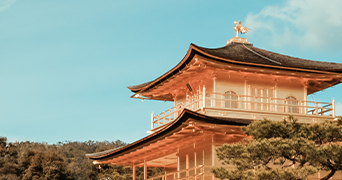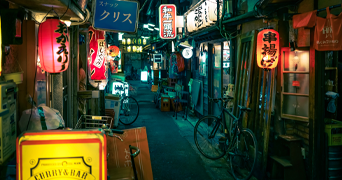
























Fushimi Inari Shrine is an important Shinto shrine in southern Kyoto. It is famous for its thousands of vermilion torii gates, which straddle a network of trails behind its main buildings. The trails lead into the wooded forest of the sacred Mount Inari, which stands at 233 meters and belongs to the shrine grounds. Fushimi Inari is the most important of several thousands of shrines dedicated to Inari, the Shinto god of rice. Foxes are thought to be Inari’s messengers, resulting in many fox statues across the shrine grounds. Fushimi Inari Shrine has ancient origins, predating the capital’s move to Kyoto in 794.
While the primary reason most foreign visitors come to Fushimi Inari Shrine is to explore the mountain trails, the shrine buildings themselves are also attractive. At the shrine's entrance stands the Romon Gate, which was donated in 1589 by the famous leader Toyotomi Hideyoshi. Behind stands the shrine's main hall (honden) where visitors should pay respect to the resident deity by making a small offering.
Fushimi Inari Shrine is located just outside JR Inari Station, the second station from Kyoto Station along the JR Nara Line (5 minutes, 150 yen one way from Kyoto Station, not served by rapid trains). The shrine can also be reached in a short walk from Fushimi Inari Station along the Keihan Main Line.

If you’ve ever clicked on a rundown of “places to see before you die” or a list of the most beautiful forests in the world, chances are you’ve seen a photo of Sagano. Located in the gorgeous Arashiyama district of western Kyoto, the Sagano Bamboo Forest’s popularity has expanded in recent years, coinciding with the rise in overall tourism arrivals in Japan. Though it’s the beauty of the bamboo that brings in the masses, those distinct rustling sounds have become an attraction in their own right.
A few years ago, the Ministry of Environment included the Sagano Bamboo Forest on its list of “100 Soundscapes of Japan” — a selection of everyday noises intended to encourage locals to stop and enjoy nature’s music.
For the best experience, head out early in the morning or late evening and avoid weekends completely, when Japanese day-trippers descend on the area — especially in the fall and spring. (There’s no admission fee and it’s open 24/7.)

As an island nation, it’s no surprise that Japan has plenty of beautiful beaches everywhere. Japan’s beaches are always clean, with emerald green waters and soft white sands to please everybody. With plenty of activities always available — from just soaking up the sun to boat tours to snorkeling — they are also very popular as a summer getaway for city dwellers.
The Okinawa prefecture has a tropical climate, making it Japan’s best area for beach activities. In addition to remote beaches and great coral reefs, the area also offers the longest beach season in the country — most beaches in Okinawa open in March and don’t close until October, with many staying open year-round. While the most famous beaches are great for snorkeling and diving, the most remote ones — especially the ones near the Kerama and Miyako islands — are a better choice if you’re after more secluded shorelines.

Japan’s cherry blossom season famously begins in April and lasts for around two weeks. The best places to see the blush-tinted blooms are in Maruyama Park, Mount Yishino, Himeji Castle and Fuji Five Lakes. Every year is different when it comes to the sakura (cherry blossom trees). As springtime begins, the country waits patiently for the first flushes of pink. Usually, the blooms burst into color between mid-March and early May and kaleidoscopic cherry blossom erupts all over Japan, filling ornamental parks and framing city canals. Although these trees exist around the world, nowhere matches Japan’s annual pandemonium of pink petals. But, if you can’t make full bloom, don’t fret. Plan a trip in February, when the equally beautiful but lesser-known plum blossoms are on show.
The earliest sakura appears in tropical Okinawa in January, the last on the northernmost island of Hokkaido in early May. What’s more, there are multiple tree varieties, each blooming at a slightly different time. Early Kawuzu blooms appears from the start of February and last until early March, mostly along the Kawzu River on the Izu Peninsula, southwest of Tokyo. Lake-blooming Omuro cherries appear early to mid-April. For peak pink in the main tourist hot spots, including Tokyo, visit between the end of March and early April, when the ubiquitous Yoshino flowers arrive and last around a week before falling quickly.

Osaka Castle is one of the most famous and historic castles in all of Japan. The iconic symbol of Osaka in the Kansai region of central Japan played an important role in the unification of Japan during the samurai era of the sixteenth century. The current main tower at Osaka Castle is a concrete reconstruction of the 17th-century castle and was completed in 1931. In its original construction back in the 16th century, it was unparalleled as the largest and best constructed castle in Japan. Today, it offers fantastic views of the city and is a popular tourist destination in spring for the beautiful cherry blossoms. The castle grounds cover approximately 60,000 square meters (15 acres) and contain thirteen structures that have been designated as important cultural assets of Japan.
The castle opens at 9:00 a.m. and is easy to reach from downtown Osaka. You can take either the JR Loop Line to JR Osakajokoen Station, or the Tanimachi Subway Line and Chuo Subway Line to Tanimachi 4-chome Station near the Otemon Gate approach to Osaka Castle.

Kinkakuji (金閣寺, Golden Pavilion) is a Zen temple in northern Kyoto whose top two floors are completely covered in gold leaf. Formally known as Rokuonji, the temple was the retirement villa of the shogun Ashikaga Yoshimitsu, and according to his will it became a Zen temple of the Rinzai sect after his death in 1408. Kinkakuji was the inspiration for the similarly named Ginkakuji (Silver Pavilion), built by Yoshimitsu’s grandson, Ashikaga Yoshimasa, on the other side of the city a few decades later. Kinkakuji is an impressive structure built overlooking a large pond, and is the only building left of Yoshimitsu’s former retirement complex. It has burned down numerous times throughout its history including twice during the Onin War, a civil war that destroyed much of Kyoto; and once again more recently in 1950 when it was set on fire by a fanatic monk. The present structure was rebuilt in 1955.
Kinkakuji can be accessed from Kyoto Station by direct Kyoto City Bus number 101 or 205 in about 40 minutes and for 230 yen. Alternatively, it can be faster and more reliable to take the Karasuma Subway Line to Kitaoji Station (15 minutes, 260 yen) and take a taxi (10 minutes, about 1300 yen) or bus (10 minutes, 230 yen, bus numbers 101, 102, 204 or 205) from there to Kinkakuji

Kumano Kodo (熊野古道, Kumano Kodō) refers to a network of pilgrimage trails through the southern Kansai region. The Kodo (“old ways”) are a key part of the region’s UNESCO designation, and have been in use for over 1000 years. They are the only pilgrimage routes besides the Camino de Santiago to be designated a world heritage site.
The pilgrimage routes developed as a way for people to move between the sacred areas on the Kii Peninsula. At the center of this religious area are the three Kumano shrines: Hongu Taisha, Hayatama Taisha and Nachi Taisha, collectively known as Kumano Sanzan.
By the 12th century, the Kumano Sanzan were well known shrines in Japan, drawing pilgrims from Kyoto, Osaka and beyond. More than just a means to reach the three shrines, the pilgrimage trails were designed to be a religious experience in themselves and often pass through difficult, even dangerous, mountain terrain.